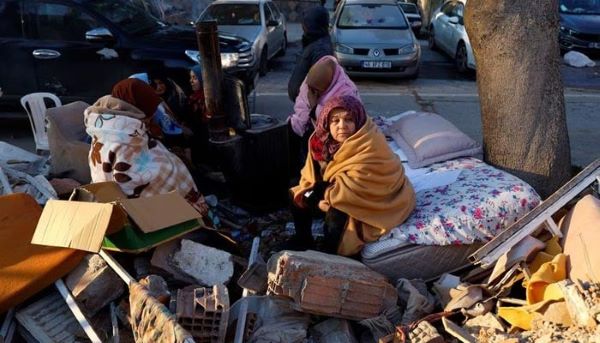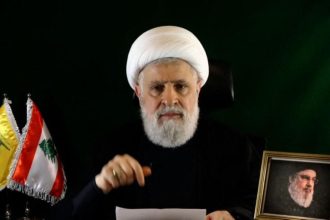President Tayyip Erdogan on Wednesday admitted to problems with his government’s initial response to a devastating earthquake in southern Turkey amid anger from those left destitute and frustrated over the slow arrival of rescue teams.
Erdogan, who contests an election in May, said on a visit to the disaster zone that operations were now working normally and promised no one would be left homeless, as the combined reported death toll in Turkey and neighboring Syria rose past 12,000.
But across a swathe of southern Turkey, people sought temporary shelter and food in freezing winter weather and waited in anguish by piles of rubble where family and friends may lie buried. Rescuers were still digging out some people alive. Others were found dead.
There were similar scenes and complaints in neighboring Syria, where the impact of Monday’s huge quake extended to.
The death toll from both countries was expected to increase as hundreds of collapsed buildings in many cities became tombs for people asleep in their homes when the quake hit in the early morning.
In the Turkish city of Antakya, dozens of bodies, some covered in blankets and sheets and others in body bags, were lined up on the ground outside a hospital.
Families in southern Turkey and Syria spent a second night in the cold.
Many in the disaster zone had slept in their cars or the streets under blankets, fearful of returning to buildings shaken by the 7.8 magnitude tremor — Turkey’s deadliest since 1999 — and by a second powerful quake hours later.
“Where are the tents? Where are food trucks?” said Melek, 64, in Antakya, saying she had not seen any rescue teams. “We survived the earthquake but will die here due to hunger or cold here.”
The confirmed death toll rose to 9,057 in Turkey on Wednesday, and in Syria had climbed to at least 2,950, according to the government and a rescue service operating in the rebel-held northwest.
Turkish authorities released video of rescued survivors, including a young girl in pajamas, and an older man covered in dust, an unlit cigarette clamped between his fingers as he was pulled from the debris.
In Syria’s Aleppo, staff at the Al-Razi hospital attended to a man with bruised eyes who said more than a dozen relatives, including his father and mother, were killed when the building collapsed.
“We were 16, and 13 of us died. My brother, one-and-a-half-year-old niece, and I got out. Thank God,” he said.
“My father, my mother, my brother, his wife and their four children. My brother’s wife and two kids who got out with me also died.”
Election impact?
Erdogan, who has declared a state of emergency in 10 provinces and sent troops to help, arrived in Kahramanmaras to view the damage and see the rescue and relief effort.
Speaking to reporters, with the wail of ambulance sirens in the background, Erdogan said there had been problems with roads and airports, but “we are better today.”
“We will be better tomorrow and later. We still have some issues with fuel … but we will overcome those too,” he said.
However, the disaster posed a challenge to him in the May election that was already set to be the toughest fight of his two decades in power.
Any perception that the government failed to address the disaster properly could hurt his prospects. But, on the other hand, analysts say he could rally national support around the crisis response and strengthen his position.
Bodies in blankets
The quake toppled thousands of buildings, including hospitals, schools and apartment blocks, injured tens of thousands, and left countless people homeless.
Entire streets in Kahramanmaras, near the epicenter, were reduced to rubble, drone footage showed, with plumes of smoke rising from fires across the town. Hundreds of tents were set up as shelters in a sporting venue.
Reuters journalists saw around 50 bodies draped in blankets on a sports hall floor.
Kneeling on the floor, a woman wailed with grief and embraced a body wrapped in a blanket.
Turkish authorities say some 13.5 million people were affected in an area spanning roughly 450 km (280 miles) from Adana in the west to Diyarbakir in the east. Syria killed people as far south as Hama, 250 km from the epicenter.
‘Under the rubble.’
In Syria, the relief effort is complicated by a conflict that has partitioned the nation.
Residents in Syrian government-held territory have described the authorities’ response as slow, with some areas receiving more help than others. State news agency SANA quoted Hussein Makhlouf, minister of local administration and environment, saying the state had opened 180 shelters for displaced people.
In Jandaris in northern Syria, rescue workers and residents said dozens of buildings had collapsed.
Standing around the wreckage of a 32-apartment building, relatives of people who had lived there said they had seen no one removed alive. A lack of heavy equipment to lift large concrete slabs impeded rescue efforts.
Rescue workers have struggled to reach some of the worst-hit areas, held back by destroyed roads, poor weather and a lack of heavy equipment. Some areas are without fuel and electricity.
A rescue service operating in insurgent-held northwest Syria said the number of dead had climbed to more than 1,280, and more than 2,600 were injured. The Syrian health minister said the number of dead in government-held areas rose to 1,250.
Across the street from an Aleppo apartment building reduced to rubble, 25-year-old Youssef has waited for two days for news of his father, mother, brother, sister and son.
He said he had heard and spoken to them, but poorly equipped rescue workers had not been able to reach them.
“I talked to them and heard their voice, but unfortunately, as you can see here, they’re very slow at work, and they don’t have enough equipment,” he said. (Reuters)






